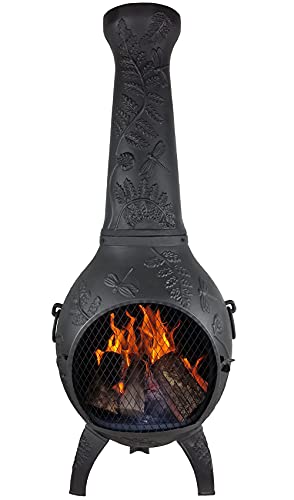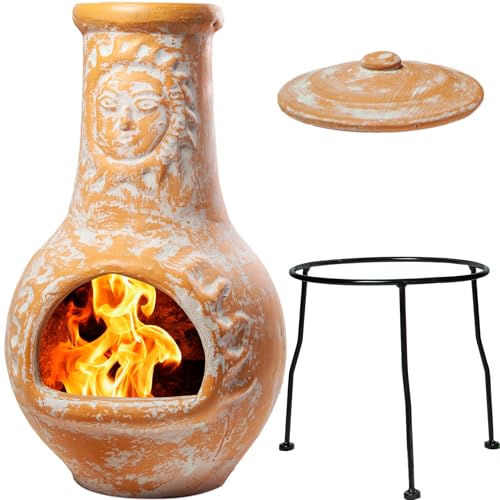Small Chiminea Tools To Ease Your Everyday Lifethe Only Small Chiminea…
페이지 정보

Hildegarde
2024-12-05
-
68 회
-
0 건
본문
 A Small Chiminea Provides Warmth Without the Mess
A Small Chiminea Provides Warmth Without the Mess With this small chiminea, you get all the warmth of a wood-burning fireplace without the mess. Place newspaper lightly scrunched in the log grate, sand grate, or log grates and add logs and kindling before lighting.
With this small chiminea, you get all the warmth of a wood-burning fireplace without the mess. Place newspaper lightly scrunched in the log grate, sand grate, or log grates and add logs and kindling before lighting.This stylish black steel chiminea features an oxidized finish that adds a casual look. The 360-degree grate is ideal for burning flames, while the high chimney channels smoke away from you.
Types
A small chiminea is a fire pit that provides an extra element of warmth to an outdoor seating area or patio. They are also a great alternative to a BBQ grill for outdoor cooking. They are available in various materials, including terracotta clay, cast iron to steel. They can be made in a traditional style or a more contemporary style.
Certain models come with a chimney which directs smoke away the seating area. This is a great feature when you reside in a location that has regulations on the amount of smoke outdoor fireplaces and other sources of heat can emit. Some models also come with an ash catcher and a spark screen inside the chimney. Depending on the size of your space you may be interested in a chiminea that can support a large fire or that holds a significant amount of wood.
The material of your chiminea will have an immediate impact on its performance and appearance in your outdoor space. Terra cotta models are classic but they can also be damaged by the elements. Metal chimineas are more durable but may require a protective coat to prevent rust. A hybrid chiminea is composed of a mixture of stainless steel and cast iron. It could have the best characteristics of both.
The size of your chiminea may also affect how much heat is produced. A larger chiminea is likely to be heavier and cost more, however it also produces more heat than a smaller one.
Chimineas are typically decorated with a decorative surface, which adds charm. Some are adorned with carvings or ornaments while others have plain lines and a plain look. Some models have lids to keep children and pets away from the flames. Some models have doors that make it easier to add fuel or remove the ashes. You can find chimineas with built-in barbecues, which allows you cook food over an open fire pits & chimineas.
Safety
If you're considering buying a small chiminea, there are a few important safety measures to keep in your mind. Chimineas aren't necessarily dangerous however they can get hot and pose a danger to children and pets when you're not cautious. Taking a few precautions will ensure that you're able enjoy your chiminea safely for many years to come.
It is important to understand that a wood stove or fireplace is not an fireplace chiminea. In contrast to these types of devices, they don't have dampers to regulate burning, and they can be easily broken when handled improperly.
Use a fire-resistant lid on your chiminea. This will prevent rain from entering and damaging the stack. It also helps reduce the smoke nuisance. You might want to consider buying an independent fireproof frame that can be positioned above the stack of smoke. This will protect it from the weather.
mexican chimineas can create a lot of sparks when burning therefore it is best to keep them away from flammable materials such as fences, clothes lines, and plants. You should also clear the area surrounding your chiminea before lighting it. Make sure that there are at least six feet of space between it and anything that could ignite.
Another measure to protect yourself is to not use gasoline, lighter fluid or any other accelerant in your chimney. These liquids pose dangerous to fire and could cause an explosion in the chimney. Water should never be used to put out an igniting chiminea because it could cause the chinese clay to crack and even break.
Use only wood to heat your chiminea. It emits less smoke than other fuels. When you light your chiminea, begin with small pieces of kindling and then add larger logs to the flames. If you can't ignite the fire quickly, try balling up newspapers and laying it against the grate in the stack. This will create powerful draft that quickly ignites the paper and your kindling.
Never burn a chiminea indoors since it can release harmful carbon monoxide fumes which are lethal to people and animals alike. It could also cause serious damage to the home and pose a fire hazard.
Maintenance
A chiminea can be a beautiful feature for any outdoor space, and it provides warmth and ambiance when used regularly. Regular maintenance will improve its appearance, reduce injuries and dangers to safety and ensure that it can be enjoyed for a long time to come. Regular inspections and cleaning of both the exterior and interior should be part of routine maintenance, as should appropriate storage in non-seasonal weather conditions.
Chimineas must be placed in an area which is clear of branches and structures with overhangs, and also away from combustible materials such as concrete and pavers. Placing a chimney directly on top of a roof or any other structure is dangerous, as sparks can be released from the chimney and ignite anything that is above it. The area should be clear and large enough to hold the entire chiminea, including the flue, with a few feet of clearance on all sides for safe use.
Chiminies should be cleaned using a mild detergent and water using soft brushes and a cloth to avoid damaging the clay surface. After washing the chiminea it should be rinsed thoroughly and then allowed to dry completely. Prior to cleaning, it is important to get rid of any ash that has accumulated in the chimney and the bowl of the chiminea. Wearing gloves during the cleaning process is vital to avoid contact with hot soot or ash. During the cleaning process, be sure to examine the exterior and interior of the vehicle for any chips or cracks that might require to be repaired.
The majority of chiminea stores sell clay repair kits that can be used to repair cracks. These kits include all the necessary adhesives and sealants to properly fix minor cracks and fractures. If a fracture is left untreated in time, it could become an issue that threatens the safety and integrity of the chiminea.
In order to keep the chiminea in good shape it must be fuelled by natural wood products that are well-seasoned and dry. Burning paint or treated wood, as well as plastics and trash can cause toxic fumes to be released into the chiminea. A properly-used fuel and regular maintenance can prevent cracks and damage caused by excessive heat. It is also essential to manage the size of fires in a chiminea, avoiding large, roaring flames which can cause thermal shock and stress to the clay.
Cleaning
A well-maintained chiminea will bring many enjoyable evenings of warmth and sociability. Like most outdoor furniture and equipment, a chiminea requires to be maintained regularly to ensure optimal performance. Security is the most important factor. Goggles and gloves are essential to protect your skin during cleaning. When cleaning the chiminea it is crucial to ensure that the chiminea has been completely cool. This will not only protect your skin, but also avoid inhalation of dangerous particles that may still be hot after previous fires.
Before beginning the cleaning procedure, remove any large chunks of ash that have been accumulating in the chiminea and dispose of them in a safe way. Using a wire brush, gently scrub off any loose rust, remembering to wear your protective gear. A light sanding is beneficial, too, as this can help remove any particles of rust that are missed by the wire brush and smooths the chiminea's surface, ready for repainting with a suitable high-heat paint designed for grills or fireplaces.
Many home improvement stores offer clay repair kits. It is a good idea to carry out this inspection before your first use of the chiminea, as it will help to strengthen the big clay chiminea and prepare it for regular heating. It's also a great method to check for any cracks or other damages that might not be apparent when the chiminea isn't in use.
It is important to remember that a chiminea is to be used outdoors on a non-flammable foundation such as a concrete slab, sand or a hearth pad. This is particularly important when there are children or pets around who may be tempted to play near the flames or if your chiminea's located near flammable materials like wooden fences plants, gazebos, and furniture. It's also an ideal idea to put a lid on top of your chiminea when not being used, in order to reduce the risk of fires spreading.
